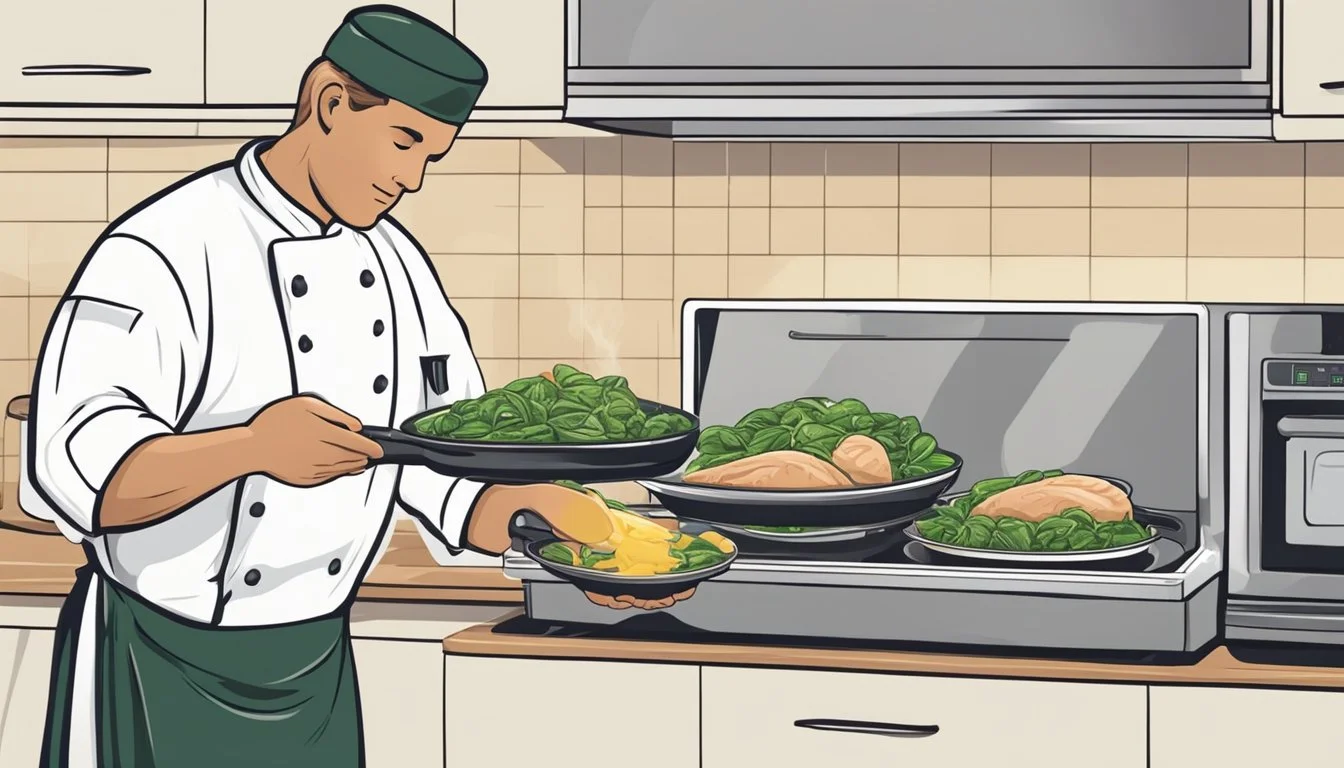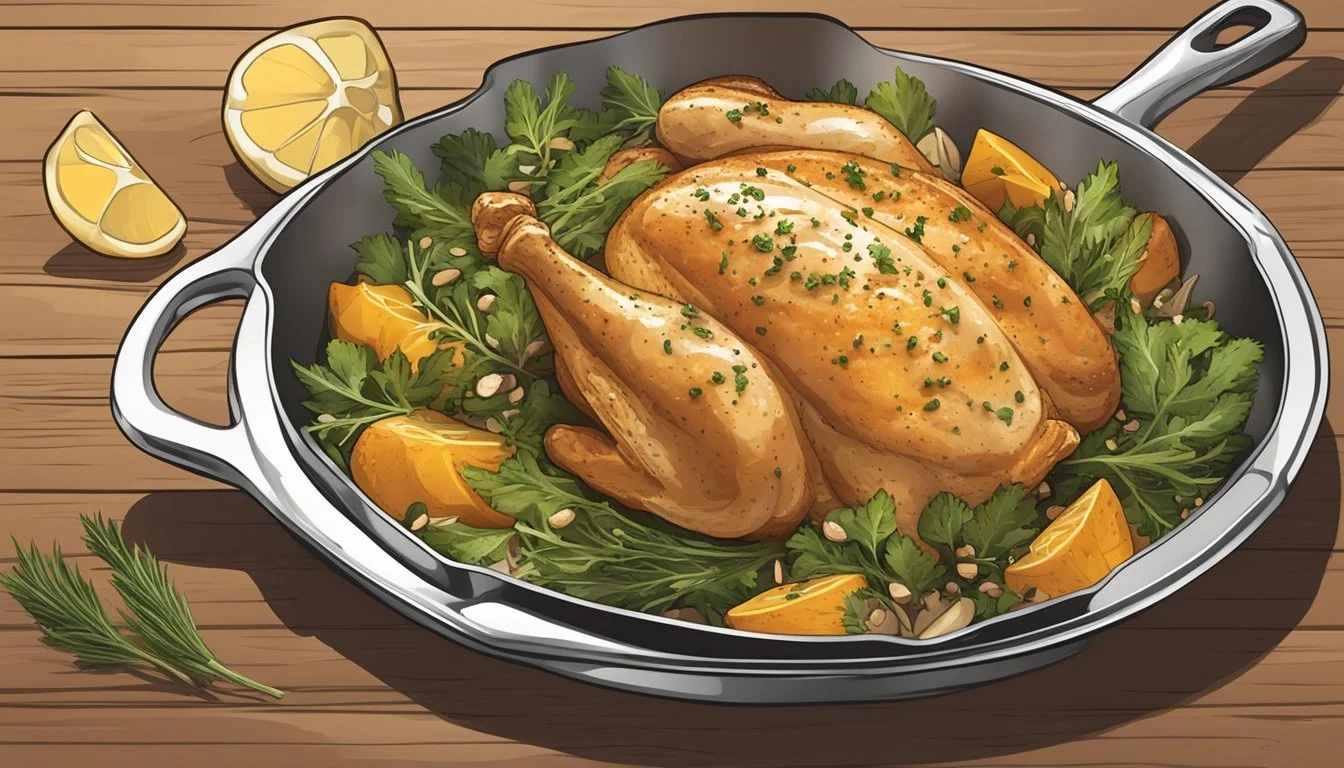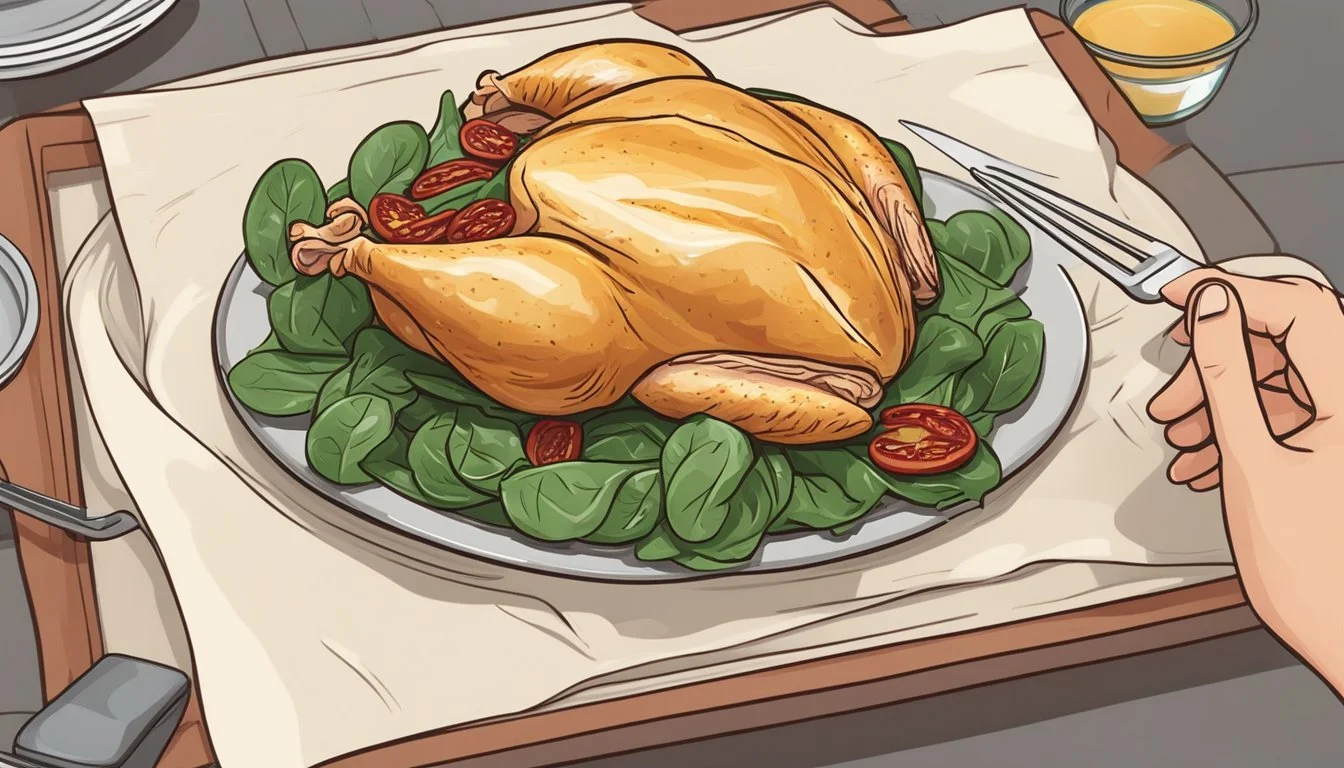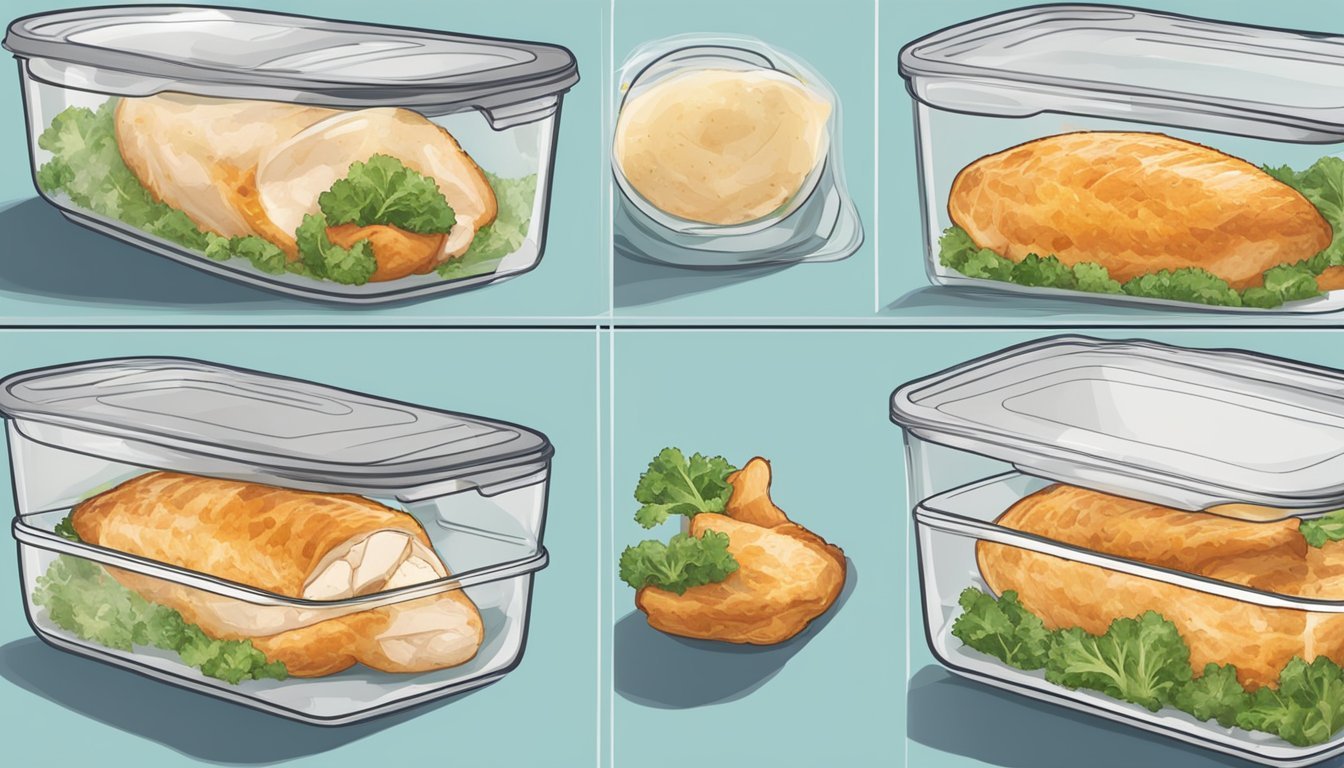Stuffed Chicken Breast Recipe
Stuffed chicken breast is a versatile and flavorful dish that transforms the simple skinless chicken breast (What wine goes well with chicken breast?) into a gourmet meal. The process involves creating a pocket within a boneless chicken breast, filling it with a variety of ingredients, and then cooking to perfection. A popular choice for fillings includes a blend of cheeses such as mozzarella, feta, swiss, and parmesan, offering a creamy and satisfying taste. Spinach is another common ingredient that can be used fresh or thawed from frozen, combined with cheeses such as cream (how long does cream last?) cheese to create a rich spinach stuffed chicken.
The key to ensuring a juicy chicken breast with a golden brown crust is proper seasoning and cooking technique. Seasoning the meat with salt, black pepper, garlic powder, or minced fresh garlic cloves helps to enhance the flavor. For those cooking in an oven, placing the stuffed chicken in a preheated oven and cooking to the correct internal temperature, checked with a meat thermometer, ensures a safe and tender chicken. Alternatively, using an air fryer or cooking on medium to medium-high heat in a cast iron skillet can produce a satisfying meal in less time.
Preparing the stuffing mixture is a creative process where cooks can incorporate their favorite ingredients, from sun-dried tomatoes (how long do sun-dried tomatoes last?) to artichokes (What wine goes well with artichokes?), bacon, or even walnuts for added texture. Binding agents like eggs or cream cheese (how long does cream cheese last?) mixture ensure that the stuffing remains intact during the cooking process. Chefs recommend serving this chicken dish alongside complementary sides such as green beans, mashed potatoes, or a simple salad dressed with balsamic vinegar (how long does balsamic vinegar last?) to round out the meal for weeknight dinners (What wine goes well with dinner?) or special occasions.
Selecting Ingredients
The success of a stuffed chicken breast recipe hinges on the quality of the ingredients. Carefully selected chicken breasts, fresh vegetables, and the right cheese varieties can transform this dish into a memorable meal.
Choosing Quality Chicken Breasts
Select skinless, boneless chicken breasts for a uniform cooking experience and to facilitate easy stuffing. Look for breasts that are plump with a pale pink hue, indicating freshness. Avoid any pieces with a grey tint or that emit a strong odor, as these are signs of potential spoilage. The ideal thickness for a chicken breast to be stuffed is about three-quarters to one inch, allowing enough room for the stuffing without requiring too much cooking time. This ensures a juicy chicken breast after baking.
Picking Fresh Vegetables
Incorporating vegetables such as fresh spinach or sun-dried tomatoes adds not only flavor but also nutritional value to your dish. For the best taste and texture, select vegetables that are bright in color and firm to the touch. Garlic should be plump and firm with unbroken, dry skin. When spinach is part of your recipe, choose fresh leaves over frozen for a less watery filling, ensuring they are clean and vibrant without any wilting or yellowing.
Types of Cheese for Stuffing
The cheese is crucial for achieving a cheesy fillings that is both flavorful and satisfying. Common choices include:
Mozzarella cheese: Versatile, with a mild taste and excellent melting properties, making it a favorite for a gooey, stringy stuffing.
Feta cheese: Offers a tangy kick, pairing well with Mediterranean-inspired ingredients such as spinach and sun-dried tomatoes.
Parmesan cheese: Adds a salty, nutty flavor to the stuffing, and it's ideal for creating a more complex taste profile.
Cream cheese mixture: Often used as a base for many stuffings to provide creaminess and bind other ingredients together.
Ensure the cheese is freshly grated or crumbled for the best integration into the stuffing and optimal melting during cooking.
Preparation and Techniques
When preparing a stuffed chicken breast recipe, attention to detail is crucial for achieving a succulent and flavorful dish. Properly cleaning the chicken, crafting a well-seasoned stuffing mixture, and skillfully stuffing and securing the chicken breasts are steps that cannot be overlooked for the perfect chicken dinner.
Cleaning and Preparing Chicken
Before handling the chicken breasts, it's important to clean them thoroughly under cold running water, then pat them dry with paper towels. Make sure each boneless chicken breast is free of bones and trim any excess fat. To prepare the chicken for stuffing, lay the breast flat and use a sharp knife to make a pocket in the side, being careful not to cut all the way through. For even cooking, the breasts should be uniform in thickness, which might occasionally require gently pounding the meat with a meat mallet.
Creating the Stuffing Mixture
A delicious stuffing begins with combining the right balance of ingredients in a medium bowl. Mix cheeses such as mozzarella, feta, or cream cheese depending on the recipe. Incorporate vegetables like chopped fresh spinach or artichokes and aromatics such as minced garlic cloves or onion to enhance the flavor. Season the mixture with salt, black pepper and any additional herbs or spices such as Italian seasoning. For an even richer filling, sautéing ingredients like bacon or mushrooms before mixing can add depth.
When it comes to getting the best deals, buying Italian seasoning online is the way to go!
Stuffing and Securing the Chicken
Once the stuffing is prepared, the next step is to fill the pockets of each chicken breast. It's essential not to overstuff to ensure the chicken pockets close and cook evenly. Carefully spoon or pipe the stuffing mixture into each pocket, then secure the opening with toothpicks. This keeps the stuffing from spilling out during the baking process. To achieve a golden brown exterior, sear the stuffed breasts in a hot skillet with a tablespoon of olive oil over medium-high heat before transferring to a preheated oven or air fryer to finish cooking. Use a meat thermometer to check the internal temperature, which should reach 165°F (74°C) for safe consumption.
For the most extensive selection, I suggest buying a skillet, olive oil, and meat thermometer online!
Cooking Methods
Stuffed chicken breast is a versatile dish that can be cooked using various methods. Each technique provides a different texture and finish to the chicken, ensuring that there is a method that matches everyone's taste preferences and dietary needs.
Baking the Stuffed Chicken Breast
Baking is a popular and straightforward method for cooking stuffed chicken breast. A typical approach involves preheating the oven to 375°F (190°C) and preparing a baking dish with a light coat of olive oil to prevent sticking. The chicken breasts, seasoned with salt, black pepper, garlic powder, and optionally paprika, should be filled with a mixture of ingredients such as mozzarella cheese, cream cheese mixture, feta cheese, or spinach filling. Placing the stuffed breasts in the baking dish, they should be cooked until the internal temperature reaches 165°F (74°C), ensuring the chicken is juicy and safe to eat.
Save time and effort by ordering a baking dish, salt, black pepper, garlic powder, and paprika online!
Using an Air Fryer for a Crispier Crust
For those seeking a crispier crust, the air fryer is an excellent choice. To use, the air fryer should be preheated if required by the manufacturer. Season the chicken breast similarly to the baking method, then cook it at a medium-high temperature, usually around 360°F (182°C), until it reaches an appropriate internal temperature. The air fryer circulates hot air around the chicken, providing a consistently golden brown and delicious outer layer.
Stovetop Cooking Alternatives
The stovetop offers a quick and dynamic cooking alternative. Begin by heating a cast iron skillet or oven-proof skillet over medium-high heat with a tablespoon of olive oil. Once hot, add the stuffed chicken and sear it until it's golden brown, usually for about 3-4 minutes on each side. Afterward, reduce the heat to medium-low and continue to cook until the chicken reaches the correct internal temperature. This method helps to achieve a tender chicken while keeping the stuffing moisture retained.
In each method, it's crucial to utilize a meat thermometer to ensure the chicken is cooked thoroughly. Whether it's prepared in an oven, air fryer, or on the stovetop, a properly cooked stuffed chicken breast should read an internal temperature of 165°F (74°C), providing a safe and juicy chicken breast for any chicken dinner.
Flavor Enhancements
When elevating a stuffed chicken breast recipe, incorporating a variety of herbs and spices, as well as the richness of bacon, can transform the dish into an extraordinary chicken dinner experience.
Herbs and Spices Variety
Selecting the appropriate herbs and spices is crucial for infusing chicken with vibrant flavors. A combination of garlic powder, or freshly minced garlic cloves, with classic Italian seasoning can provide a traditional taste. To cater to different preferences, black pepper and kosher salt are essentials for a well-seasoned chicken breast. For an adventurous twist, adding red pepper flakes (how long do red pepper flakes last?) can introduce a spicy kick. Thyme, whether dried or fresh, imparts a subtle earthiness, which complements the tender chicken.
Examples of Spice Mixes for Chicken:
Classic: Italian seasoning, kosher salt, black pepper
Spicy: Red pepper flakes, onion powder (how long does onion powder last?), cayenne pepper
Skip the lines and order your red pepper flakes, onion powder, and cayenne pepper online for a stress-free shopping experience!
Incorporating Bacon for Richness
Bacon not only adds a luxurious richness but also contributes a crispy texture to the stuffed chicken breast. Wrapping the chicken pockets with slices of bacon before baking ensures that the juices are sealed within, resulting in a juicy chicken breast with a golden-brown finish. The bacon introduces a smoky flavor that permeates the meat and harmonizes with the cheese fillings such as mozzarella, swiss, or feta cheese mixed with cream cheese for a lush spinach stuffed chicken.
Bacon Preparation Tips:
Wrap it: Lay strips of bacon over the chicken breast flat before baking.
Underneath: Place bacon on the baking sheet under the chicken for extra flavor.
Inside: Chop cooked bacon into small pieces and add to the stuffing mixture for an internal surprise.
Side Dishes
Selecting the perfect accompaniments can elevate a stuffed chicken breast meal, offering a balance of flavors and textures. The choice of side dishes can complement the rich and savory notes of the chicken, spiced with hints of garlic and filled with a creamy blend of cheeses. Three key considerations include freshness, cooking method, and how the side dish’s flavor profile matches that of the chicken.
Pairing with Vegetables
Serving vegetables alongside stuffed chicken breasts is a smart way to introduce color and nutrition to the meal. Consider these options:
Roasted Green Beans: Tossed lightly with olive oil, seasoned with kosher salt and a touch of black pepper, then roasted to perfection.
Steamed Broccoli: A simple, yet flavorful side, providing a crisp texture and subtle earthiness, enhanced by a sprinkle of parmesan cheese.
Sautéed Spinach: Quick to prepare with minced fresh garlic in a hot skillet, wilting just enough to meld flavors.
Roasted Brussels Sprouts: Becoming golden brown and crisp in the oven, they offer a sweet and nutty complement when lightly seasoned.
Complementing with Starches
Starchy sides are ideal to round out the meal, offering a comforting counterpoint to the tender chicken. They should be chosen for their ability to sop up any cream sauce or fillings that might escape the chicken pockets. Options include:
Mashed Potatoes: Creamy and smooth, these can be flavored with roasted garlic or sour cream for extra tang.
Crispy Potato Wedges: Oven baked until the crust is crispy, they provide a satisfying crunch with each bite.
Rice (how long does rice last?) Pilaf: A fluffy bed of seasoned rice can absorb the flavors of the stuffing ingredients, tying the dish together.
Dinner Rolls: Fresh from the oven, they're wonderful for scooping up any leftover cream cheese mixture or savoring the juices of the juicy chicken breast.
Special Diet Considerations
When preparing stuffed chicken breast recipes, it's important to consider dietary restrictions or preferences. Adapting the recipe can help meet low carb, keto, or gluten-free requirements without sacrificing taste or texture.
Low Carb and Keto Options
For individuals following a low-carb or keto diet, substitutions can be made to traditional stuffing ingredients. Skinless chicken breasts are naturally low in carbohydrates and high in protein, making them an excellent base. Mozzarella cheese, feta cheese, and parmesan cheese can be used in stuffings for added flavor without increasing carbs. To keep the dish low-carb:
Use fresh spinach instead of bread or crouton-based fillings.
Black pepper and Italian seasoning can provide flavor without carbs.
Omit high-carb items like potatoes; instead, consider adding high-fat ingredients such as cream cheese or bacon.
For a golden-brown finish without breadcrumbs, cook the stuffed chicken breasts in a cast-iron skillet until the meat’s internal temperature reaches 165°F.
Cooking tip: Instead of a traditional baking dish, you can cook the chicken in an air fryer for a crispy outside while keeping the inside tender and juicy.
Gluten-Free Adaptations
To create a gluten-free stuffed chicken breast dish, it's crucial to avoid anything that contains wheat, barley (how long does barley last?), or rye. Here's how to adapt your recipe:
Use gluten-free cheeses like swiss, cheddar, or those already mentioned for the keto option.
Thicken your cream sauce with cornstarch (how long does cornstarch last?) or a gluten-free flour blend instead of regular flour.
If a recipe calls for breadcrumbs, substitute with crushed gluten-free crackers or gluten-free panko.
Season with salt, pepper flakes, or garlic powder for added flavor without gluten.
Baking tip: For ensuring the chicken doesn't stick, lightly coat the baking sheet with olive oil. Always check the labels of seasonings and cheeses for any hidden gluten.
Recipe Variations
Exploring different variations of stuffed chicken breast recipes not only adds excitement to your dinner rotation but also caters to a wide range of taste preferences and dietary needs.
Alternative Stuffed Chicken Recipes
Stuffed chicken breast recipes are a canvas for creativity. Home cooks can easily modify ingredients to satisfy picky eaters or to utilize what is currently in the pantry. For a Mozzarella and Spinach filling, mix together fresh spinach, mozzarella cheese, and garlic cloves; stuff into skinless chicken breasts seasoned with salt and black pepper. For a heartier option, Bacon and Cheese-Stuffed Chicken involves wrapping chicken pockets with slices of bacon and filling them with a blend of cheddar, cream cheese mixture, and green onions.
Tender Chicken Thighs (What wine goes well with chicken thighs?): Substitute chicken breasts with boneless chicken thighs for a more succulent dish.
Air Fryer Adaptation: For a quicker cook time and a crispier finish, use an air fryer instead of the traditional baking process.
Cultural Twists on Classic Stuffing
Stuffing mixtures for chicken breasts can be inspired by various cuisines offering a delightful take on weeknight dinners.
Italian: A stuffing mix of ricotta, parmesan cheese, sun-dried tomatoes, and Italian seasoning gives the chicken a Tuscan flair.
Greek: Combine feta cheese, olives, spinach, and red onion for a Mediterranean-inspired dish.
Utilizing a meat thermometer is crucial, regardless of the filling, to ensure the internal temperature of the chicken reaches 165°F (74°C) for safe consumption. Whether cooking in a cast iron skillet, baking dish, or air fryer, the key is for the chicken to reach a golden brown crust on the outside while maintaining a juicy chicken breast inside.
Storing and Reheating
When it comes to enjoying leftovers, proper storage and reheating methods are crucial for maintaining the flavor and safety of stuffed chicken breast dishes. By adhering to recommended practices, you can relish a juicy and savory chicken meal even the day after.
Best Practices for Storage
Storage:
Keep any leftover stuffed chicken breast in an airtight container.
Refrigerate promptly after the meal, ideally within two hours of cooking.
For best quality, consume refrigerated chicken within 3-4 days.
Freezing (if applicable):
Wrap each piece of chicken individually in foil or plastic wrap.
Place wrapped chicken in airtight containers or freezer bags.
Label and date the packages; use within 3 months for optimal quality.
Ensuring Quality When Reheating
Oven Reheating:
Preheat your oven to 350°F (175°C).
Place the chicken breast in a baking dish, adding a few spoons of broth or water to prevent drying.
Cover the dish with foil and heat until the internal temperature reaches 165°F (74°C).
Microwave Reheating:
Heat the stuffed chicken in a microwave-safe container.
Use a lower power setting to evenly warm up the chicken without making it tough.
Check that the chicken is thoroughly heated to the proper internal temperature.
Stovetop Reheating (ideal for chicken pieces):
Heat a skillet over medium heat with a tablespoon of olive oil or broth.
Cook the chicken on each side until it is warmed through and regains a slight crispness on the exterior.
Using a meat thermometer is the best way to ensure that reheated chicken has reached a safe internal temperature, regardless of the reheating method selected.
Safety and Tips
Ensuring safety while preparing a chicken recipe is crucial, not only to prevent foodborne illnesses but also to guarantee the best results. The following tips focus on handling raw chicken safely and achieving the correct internal temperatures.
Proper Handling of Raw Chicken
Raw chicken, including skinless chicken breasts and boneless chicken breast, should always be handled with care to prevent cross-contamination. Use separate cutting boards for raw meat and other ingredients such as fresh spinach or cheese. It's recommended to:
Wash hands thoroughly with soap and water for at least 20 seconds before and after handling raw chicken.
Clean all surfaces and utensils with hot, soapy water or a kitchen disinfectant after they've come in contact with raw chicken.
Marinate chicken in a medium bowl in the refrigerator to keep it at a safe temperature.
Cooking to Safe Internal Temperatures
Ensuring that your stuffed chicken breast is cooked to a safe internal temperature is key to preventing foodborne illnesses. The filling, whether it's a cream cheese mixture, mozzarella cheese, feta cheese, or even a more complex stuffing mixture, needs to be thoroughly heated within the sealed chicken pockets.
The safe internal temperature for chicken dishes is 165°F (74°C). Always use a meat thermometer to check the thickest part of the breast.
When cooking in an oven or air fryer, ensure that the chicken isn't touching other pieces to allow even circulation of heat.
If cooking on a stove top, whether over medium heat or medium-high heat, pay attention to the chicken turning golden brown to avoid over or undercooking.
By following these safety and cooking tips, you’ll be more likely to enjoy a juicy chicken breast that's delicious and cooked to perfection.
Conclusion
Mastery in preparing stuffed chicken breast recipes ensures a delightful chicken dinner experience, accommodating an array of tastes and dietary preferences.
Final Thoughts on Stuffed Chicken Breast Recipes
Stuffed chicken breast offers a versatile and satisfying option for any weeknight dinner or special occasion. Boneless and skinless chicken breasts serve as a canvas for a variety of stuffing ingredients, ranging from fresh spinach to a decadent cream cheese mixture. Achieving a juicy chicken breast with a golden brown exterior requires cooking to the proper internal temperature, which can be checked using a meat thermometer.
Maintaining medium heat is essential when searing the chicken in a cast iron skillet, creating a flavorful crust before transferring to a baking dish or baking sheet. Season with salt, black pepper, and additional spices like Italian seasoning to ensure the meat is well-flavored. When opting for cheeses, combinations like mozzarella cheese, parmesan cheese, and feta cheese melt into sumptuous cheesy fillings.
For those trying the recipe in an air fryer, adjust the cooking process to account for different heat dynamics, aiming for the same golden brown finish. Throughout preparation, it's important to focus on seasoning and temperature control. This approach will promote a tender chicken outcome, pleasing even picky eaters. Whether served with mashed potatoes, drizzled with balsamic vinegar, or paired with green beans, stuffed chicken breast remains a cherished dinner recipe.









